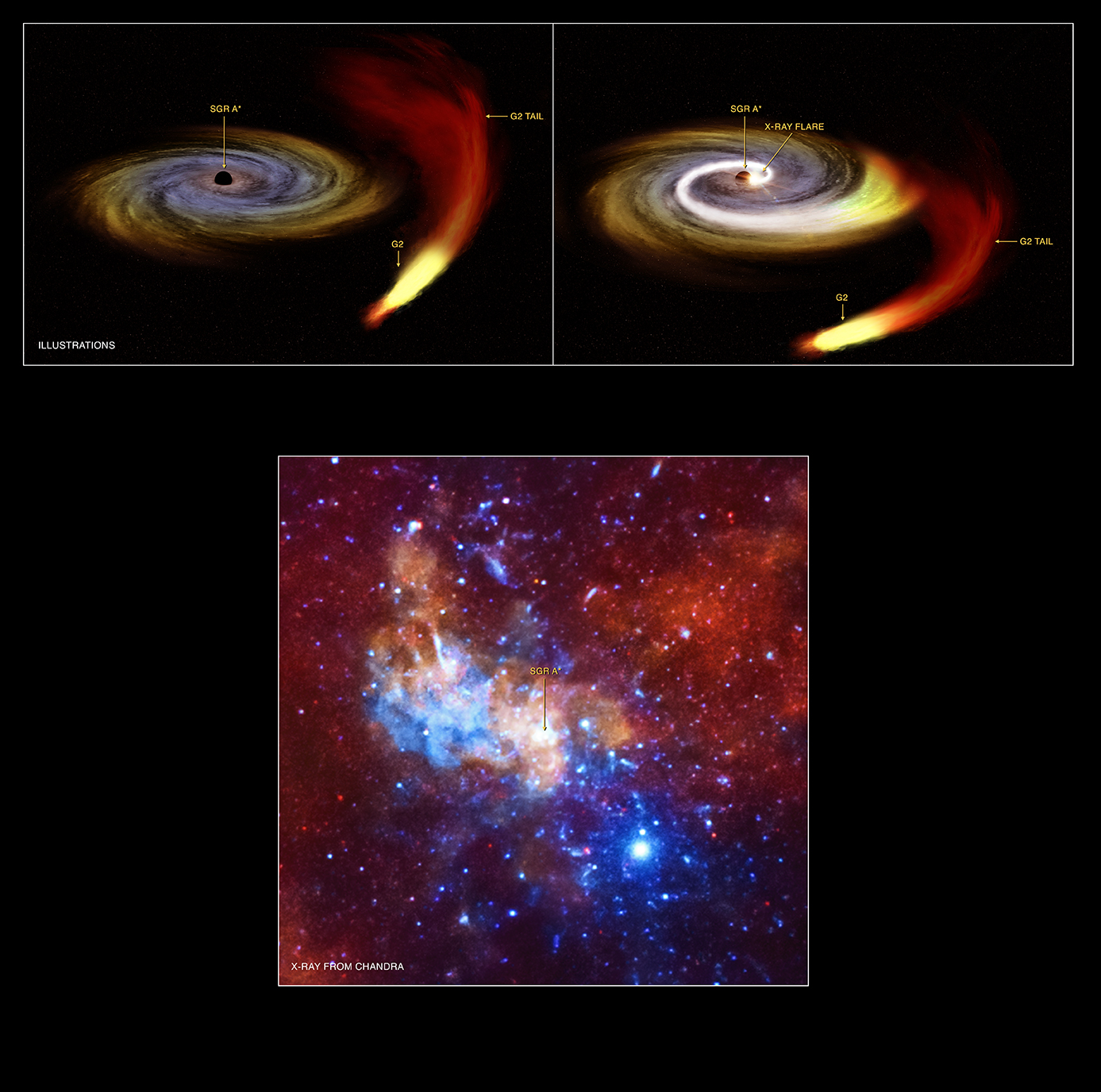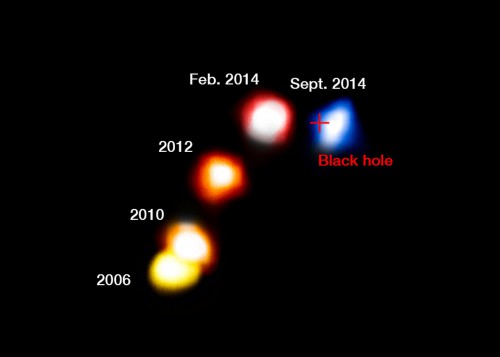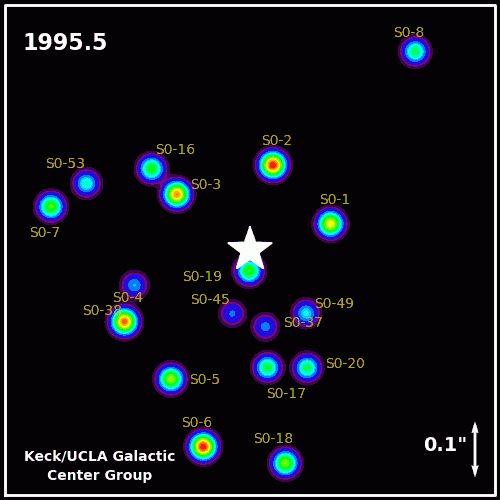
Image credit: NASA/CXC/MPE/G. Ponti et al.; Illustration: NASA/CXC/M. Weiss
For anyone who has been under clear skies far away from the all-obscuring artificial lights of civilisation, the view toward the direction of the Sagittarius constellation reveals the magnificent sight of the galactic center—a wide band of bright stars and dark dust clouds which to the naked eye looks entirely peaceful and serene. In reality, the central regions of the Milky Way are anything but, hosting a supermassive black hole, called Sagittarius A* or Sgr A* for short, which regularly feeds on any unsuspecting material that will happen to pass too close and giving off tremendous amounts of electromagnetic radiation in the process. Sgr A* has historically been a relatively quiet black hole, compared to the ones found at the centers of distant galaxies, like quasars. A series of recent observations by orbiting X-ray telescopes have revealed that our galaxy’s supermassive black hole has lately exhibited an unexpected increase in activity, in the form of bright X-ray flares which have been observed at random intervals at an increased rate.
Due to our location in the Milky Way galaxy, which is 26,000 light-years away from the galactic center, our view of the latter is heavily obscured by the large amounts of gas and dust that lie in between, making it possible to observe it in only a very small part of the electromagnetic spectrum from the ground. Nevertheless, the presence and nature of Sgr A* had been established in recent decades by a series of observations n X-ray, infrared, and radio wavelengths from ground- and space-based telescopes, revealing it to be a monstrous object with a mass of approximately 4 million times that of the Sun, which occupies a volume of space with a radius of no more than 44 million km—a little less than the diameter of Mercury’s orbit around the Sun. The surroundings of Sgr A*, out to a few light-years, have also been found to be quite complex, featuring thousands of old, red giant stars, as well as hundreds of young and bright blue-white ones and many other specimens of the cosmic zoo, like supernova remnants, neuron stars, and vast amounts of molecular gas that orbit the behemoth black hole.

Among the many closely packed objects that astronomers had observed in the vicinity of Sgr A* during the last decade was a massive hydrogen gas cloud called G2, whose orbital period around the black hole was calculated to be about 300 years. Theoretical predictions had shown that the gas cloud was ultimately on a rendezvous with oblivion and was expected to fall onto the Milky Way’s black hole in late-2013 or early-2014. Astronomers lined up every major ground- and space-based telescope for the occasion, eagerly awaiting to be treated to a spectacular celestial fireworks display, courtesy of Sgr A*. But when the time came and went, all that telescopes recorded was, well … nothing. Subsequent observations revealed that the gas cloud had instead remained intact following its close gravitational embrace with Sgr A*, leaving astronomers perplexed as to the reason why. One of the several hypotheses that have been put forth for this lack of cosmic fireworks was that G2 in reality wasn’t just a diffuse dust cloud per se, but probably represented the outer layers of a star or grouping of stars which ultimately remained unaffected by the immense gravity of Sgr A*.
An international team of astronomers, which was studying the overall activity of Sgr A* before and after the close passage of the G2 cloud, discovered something really odd. By analysing archival data that had been gathered in the last 15 years between September 1999 and November 2014 by NASA’s Swift and Chandra X-ray observatories as well as ESA’s XMM-Newton, the researchers found a ten-fold increase in the rate of bright X-ray flares from Sgr A* in just the last two years. More specifically, the astronomers discovered a total of 80 bright X-ray flares in the telescopes’ archival data, and even though for most of the last decade the Milky Way’s black hole had been relatively quiet, giving off X-ray flares once in every 10 days, that rate seemed to rapidly increase by late the summer of 2014 to one per day. “For several years, we’ve been tracking the X-ray emission from Sgr A,” says Dr. Gabriele Ponti of the Max Planck Institute for Extraterrestrial Physics in Germany and lead author of the new study that was accepted for publication at the Monthly Notices of the Royal Astronomical Society. “This includes also the close passage of this dusty object [G2]. A year or so ago, we thought it had absolutely no effect on Sgr A, but our new data raise the possibility that might not be the case.”
Even though it is tempting to assume that this heightened activity by Sgr A* might be linked to the close passage by G2, the latter’s nature is far from settled at this point, let alone its connection to the observed X-ray activity by the Milky Way’s black hole. Ponti’s team examined several hypotheses in order to account for the observations, including possible X-ray outbursts from magnetars (a kind of dead stars with very powerful magnetic fields) that lie close to Sgr A*. Yet magnetars give off X-ray flares with a certain duration and luminosity that are different from what is generally observed in the accretion disks around black holes. And even such types of stars were found to be at the same field of view where the increased X-ray flares were observed, their spectral type indicated that they didn’t originate by Sgr A*.
One perplexing aspect of the X-ray flaring activity detected by Ponti’s team is that it’s a common characteristic of stellar-mass black holes as well that are found in stellar binary systems, making it harder to distinguish whether the newly observed ones originate from the Sgr A* black hole itself or a much smaller stellar-mass one. “[The] evidence is in line with the idea that flaring activity is not a peculiarity of Sgr A⋆ (e.g. related to a process unique to supermassive black hole environments), instead it appears to be a common property of quiescent black holes,” write the researchers in their study.

That doesn’t preclude, however, that the G2 gas cloud was the one responsible for Sgr A⋆’s increase in activity. Even though no such increase was detected before and during the cloud’s closest passage from Sgr A⋆, it could well be that some residual material that had been left in the black hole’s vicinity was eventually sucked up long after the cloud itself had reached its pericentre in its orbit, leading to an increased flaring from the accretion disk around Sgr A⋆.
“At first glance, no variation on the flaring rate appears evident before and during the peri-center passage of G2,” write the researchers.” On the other hand, three flares, including a very bright one, were detected about six months after peri-center passage … the point in time when the variation of the flaring rate occurred is quite precise (the typical spacing between the 2014 XMM-Newton and Chandra observations is of the order of 1 month) and took place several months after the bulk of the material of G2 passed the peri-center. In particular no increase in the flaring rate is observed six months before (e.g. in 2013) and/or during the peri-center passage. If the observed variation in the flaring rate has anything to do with the passage of G2, this process should not stop within the next few months, but it should continue at least on a dynamical-viscous time-scale.
“There isn’t universal agreement on what G2 is,” adds Dr. Mark Morris, a professor of astronomy at the University of California at Los Angeles and member of Ponti’s team. “However, the fact that Sgr A* became more active not long after G2 passed by suggests that the matter coming off of G2 might have caused an increase in the black hole’s feeding rate.”
The only way for astronomers to shed more light to the enigma is through follow-up observations, to help determine whether what they had observed were the long-sought-for cosmic fireworks from Sgr A⋆’s latest dinning session, or if it’s a general property of black holes that hasn’t been observed before. “It’s too soon to say for sure, but we will be keeping X-ray eyes on Sgr A* in the coming months,” says Dr. Barbara De Marco of the Max Planck Institute. “Hopefully, new observations will tell us whether G2 is responsible for the changed behavior or if the new flaring is just part of how the black hole behaves.”
Dark and foreboding, black holes still continue to puzzle and fascinate while the light they give off indirectly from their eating habits can still give much clues to their utterly enigmatic nature.
Want to keep up-to-date with all things space? Be sure to “Like” AmericaSpace on Facebook and follow us on Twitter: @AmericaSpace






It is curious that nearly all galaxies have a black hole. One wonders if that is a naturally occurring process and if it is a way to “clean up” the galaxy. Fascinating article, Leonidas!
Thank you Tom!
Supermassive black holes have played a fundamental role in the formation and evolution of galaxies during the first few billion years after the Big Bang. In fact, were it not for these cosmic behemoths, galaxies as we know them would not have been created in the first place. Supermassive black holes were the central nodes around which galaxies and their constituents (stars and planets) were developed. So it’s not that surprising that every galaxy hosts one at its center.